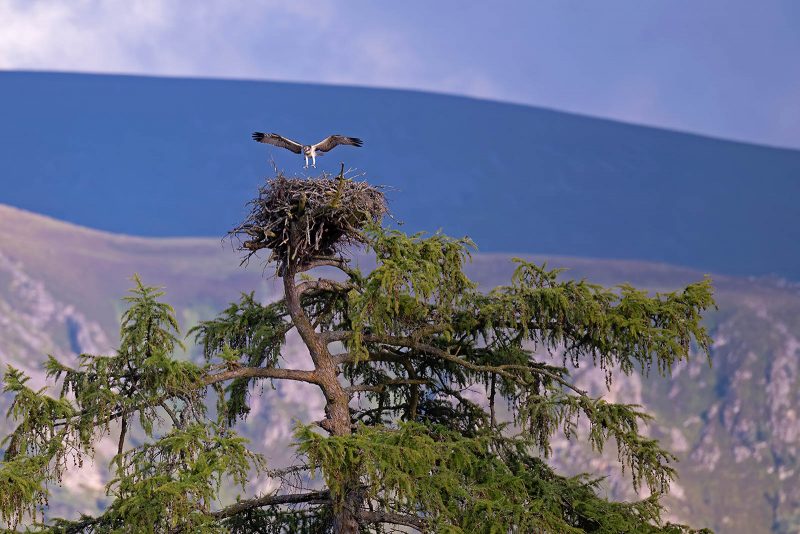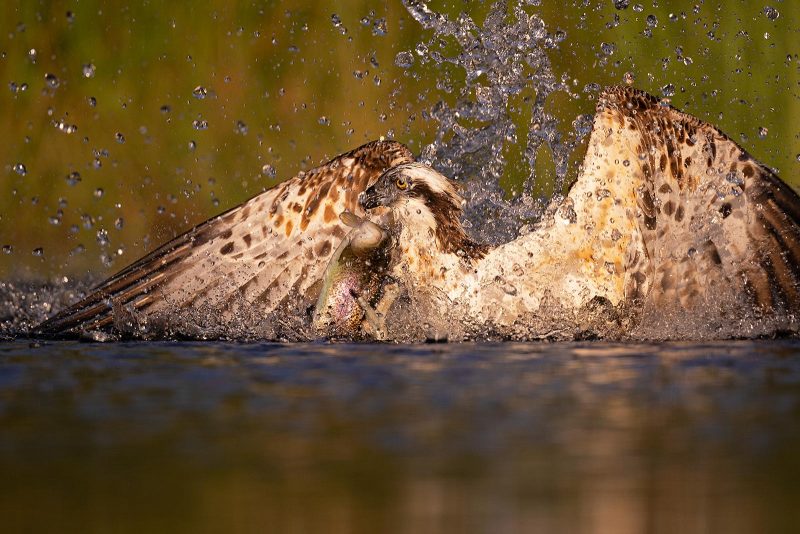How to Photograph Ospreys

Between the current pandemic and the much talked about climate crisis, it’s a time of gloom and doom overload. Of course, these issues are horrendous, but we should not overlook or indeed celebrate more the success stories in the natural world. In the UK one such success story is, surely, the return of the osprey over the past few decades.
The return of the osprey
Ospreys became extinct in the British Isles in the late 19th century, hanging on in Scotland until 1916. The cause was mainly due to various forms of human persecution – namely the fashion for specimen collecting, egg collecting, taxidermy, and shooting.


However, 38 years later (in 1954) the birds began their comeback. This was a natural recolonisation by Scandinavian ospreys, with a pair breeding at Loch Garten for the first time in nearly 4 decades. A wonderful moment – but it was a slow start and egg collection thieves still persisted; the osprey eggs were their holy grail.
In those early years, a few dedicated individuals guarded the nest round the clock until the chicks hatched safely. Without a doubt, these few folks ensured the birds’ success. Without their dedication at that crucial time, it’s unlikely the birds would have gained the foothold and security they needed.
After a few up and down years with only a couple of known pairs breeding, slowly but surely they began to establish themselves again. Largely unaided, they have now increased to around 250 pairs. Most of these are in the more remote areas of Scotland but, more recently, a welcome expansion now sees a few birds breeding in the Lake District, Northumberland, and Wales. Add in a couple of reintroduced populations in Rutland Water and Poole harbour, and the ospreys can now be seen throughout the UK. Hopefully they will continue to spread and colonise new areas.
Find Osprey photography workshops: Explore the Nature TTL Hub
New beginnings
It was back in the mid seventies that I first became aware of this unique, striking bird. A pair started nesting on a tree-covered island in a remote loch which was on the estate my gamekeeper father worked on in north Perthshire.
This was a big deal back then, as there were little more than a handful of known nests in the UK during that period. I remember seeing the huge nest for the first time and being awestruck by the sheer size of it.
Finding out more about these birds and how they travelled from West Africa to this remote highland loch intrigued me, and they very quickly became my favourite raptor. I would even go as far as to say it was the ospreys that got me into wildlife photography.
A much revered wildlife camera man, Hugh Miles, came to the estate to make a film for the RSPB about the ospreys and their return. Seeing what Hugh did, albeit with a movie camera, I was fascinated by how you could share experiences via moving pictures or stills. One scene in particular from the finished film totally amazed me: it was an osprey plunging into a pool of water and catching a fish. I had never seen anything like this before and was blown away by the sheer spectacle and drama of such a sight. I remember thinking then that one day I wanted to photograph and see this for myself.
Fast forward to the early 1980s and I was now located in the Cairngorms area where my father had moved to a new estate to work. By now the ospreys had continued to increase in population, and two pairs had established their nests on the estate where we lived – as well as several others in the nearby area. It seemed like osprey central to me, and indeed over the spring and summer months I would see them most days.
With a now growing population in the area, I would frequently see them dive in some of the local lochs and – albeit at more distant views – they were spectacular and only heightened my desire to witness and photograph this behaviour up close.
How to photograph ospreys catching fish
Ospreys are no different from many other predators. They will seek out and find prey which is more abundant and easier to catch. Easier was my initial supposition, however even with a stocked fishing loch by no means does this result in a catch with every dive. This can be very variable; sometimes the first dive will be a success and on others it will take multiple attempts.
On odd occasions I have seen an osprey dive into double figures before it finally catches a fish. Of course, missed dives still give you a photo opportunity – but there can be no doubt that when a fish is caught the whole experience and resulting images are so much more desirable. Unless you are the unfortunate fish, of course.
Another factor to keep in mind – and one you won’t know about until it happens – is their speed and how fast the dive will be. This ultimately comes down to the size of the fish the osprey catches. If it is a relatively small fish, then the dive can be extremely quick: they plunge in, grab the fish, and are up and away all within a few seconds.
However, if the fish is larger and more towards the osprey’s catch limit, the whole process can slow up dramatically. That initial plunge as the bird strikes the water is at the same speed, but once a larger fish is grasped it will pull the osprey down a little. Sometimes you can even see the bird being pulled around by the fish in a circular motion as it tries to escape.
At this moment the osprey is half-submerged, giving you a good chance to get focused onto it as the bird prepares to lunge clear of the water. With a powerful upward wing surge, the osprey breaks the water and it is at this moment – plus the following few meters – that can often result in some of the most striking image opportunities.
Keeping the bird in tracked and in focus is of course key. After the bird is up and clear, keeping up with it becomes harder. But by keeping locked on you can be rewarded with some great images if you happen to get the right wing position and the fish in full view.
What way the osprey goes can vary. This factor is very dependent on the wind direction; if you get a reasonable degree of wind speed the birds will largely prefer to fly directly into the wind as this aids their uplift. So, if possible, get yourself located with the wind on your back. However, there are always variables. Often in the early mornings – which tends to be the best time to get the birds diving – there can be no wind at all. With flat, calm conditions it does become a bit more of a guessing game and a bit of a lottery.
In these instances, I still check the wind direction on the weather forecast and even if it shows just 2mph wind from the east, I will use that as a starting basis. On a wind-free morning, and if you are lucky enough to get a few birds diving, I have seen them go in any direction. So, you just have to hope at least some come in your general direction.
On occasions, I have had a bird in the water facing me and it’s looking perfect – but then the fish will pull the bird slightly in a different direction and it ends up going the opposite direction to me. Frustrating yes, but you just have to put up with these variables on the calm mornings.
Another image to try for is the almighty splash as the osprey hits the water, for that split second you will lose sight of the bird as the water and spray covers it with a watery vail. It is one of the hardest to judge and capture, but the reward can look spectacular.
Although I have concentrated on the diving scenario, there are of course other types of image you can try and achieve. With a good population of local birds, I will on occasion happen upon one perched in a tree and this can offer a nice, more peaceful image as opposed to the drama you get in the diving pictures.
Nest photography could also be possible, but they are a Schedule 1 species and if you need to place a hide within close quarters to the nest you will need to obtain a license from NatureScot (formally Scottish Natural Heritage). However, there are a couple of well-known nests sites that you can observe and photograph from a distance. Just make sure you stay far enough away and ensure you do not disturb the birds.
Technical tips
Settings on your camera are pretty much the standard ones you would use for any flight shots. To freeze the action, try and get a shutter speed of 1000th of a second or more. Keeping your lens wide open (low f-number) will help achieve this, plus it will isolate the bird from the background.
Have your camera set to continuous high speed (aka. burst mode) as the more frames you can capture, the more chance you have of capturing the action at that key moment. You will find that in a sequence there will be some big variances between wing positions, for example. So, once you are locked on and tracking keep that shutter firing.
In the early part of the morning the light can be low, and you might have to push your ISO up to achieve a workable shutter speed. One other alternative in this situation is to go for a more creative type of shot and keep your shutter speed deliberately slow to try and get a motion blur effect.
At this early stage in the morning, you have nothing to lose in trying this technique. When the light improves, you can then revert to a higher shutter speed to freeze the action.
What lens you use is more of personal choice and will depend on the type of image you wish to achieve, as well as the location you are in. However, for the close-up action I use a minimum of 300mm and a maximum of 500mm.
If the bird is flying face-on to me, I would choose a shorter focal length (towards 300mm) as the bird would quickly fill the frame as it got closer. This risks clipping the winds in too many shots, losing part of the animal out of the frame. On occasions this can happen, and it is unavoidable.
If you do clip a wing tip out of the picture and it’s an image you particularly liked, don’t despair and bin it too quickly. Try cropping it intentionally tighter in processing and go for the “full in the frame” look, cropping the unclipped side inwards to balance the side that was out of frame. If your cropping skills are up to scratch, this can work very effectively and present you with an image you might have discarded. This technique, of course, will work with any other similar action shots.
In conclusion
By the time you are reading this, the ospreys will have left the UK and be on their journey back to West Africa; some may even be there already. It’s now 30 plus years since I photographed my first osprey dive, and the buzz and wonder I get out of seeing and photographing this incredible behaviour is as alive today as it was on that very first occasion. I, for one, cannot wait to see them safely return again next spring.
















